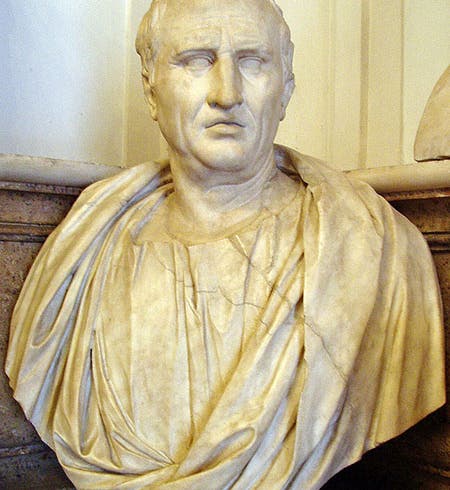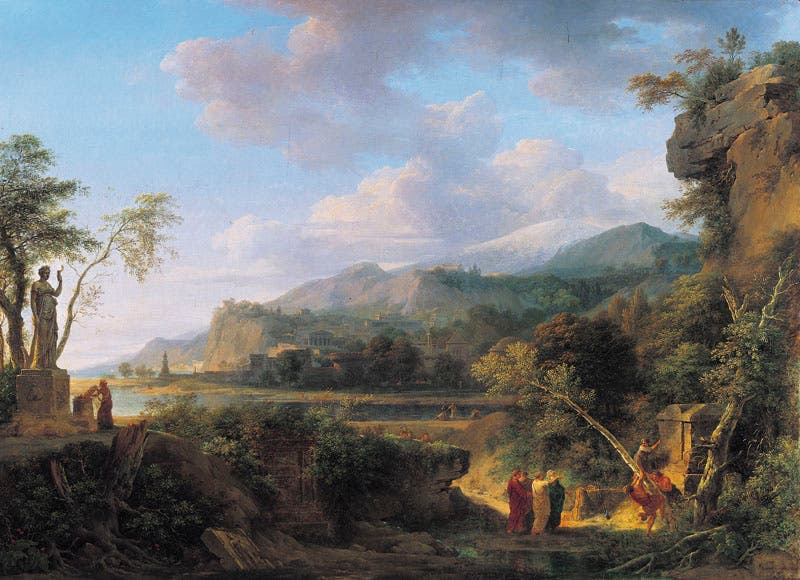Scientist of the Day - Cicero
Marcus Tullius Cicero, a Roman statesman, writer and orator, died Dec. 7, 43 B.C.E. Cicero was not much of a philosopher, and even less of a scientist. But if you were to argue that, without Cicero, there would have been no revival of ancient science in the Renaissance, I would not put up much resistance. What Cicero was really good at was writing and speaking. In the opinion of many, Cicero was the finest master of the Latin tongue who ever lived. In 1345, an encounter with some letters of Cicero inspired Francesco Petrarch to undertake a life-long search for other ancient writings and launch what we know as Renaissance humanism. Later humanists, such as Poggio Bracciolini, became equally enamored of Cicero and sought lost Ciceronian manuscripts in the monastic libraries of Switzerland and Germany; Bracciolini found quite a few, but he also discovered manuscripts of the architect Vitruvius (in 1414); the astronomer Manilius (1416), and the atomist Lucretius (1417). Still other humanists uncovered long-lost works of Archimedes and Hero of Alexandria, the two foremost students of machines of antiquity. And these scientific works, the byproducts of a search for Ciceronian letters and orations, were the inspiration for the likes of Guidobaldi del Monte and Galileo Galilei. Galileo, by all accounts, could not have cared less about Ciceronian style. But were it not for the attraction that Cicero held for earlier humanists, Galileo would likely have spent his life playing the lute and composing madrigals like his father and brother.
Cicero's writings, in addition to his letters, include the Tusculan Disputations and On the Nature of the Gods; Voltaire praised the latter as perhaps the best book of all Greek and Roman literature. Neither contained much about science, although there is some valuable discussion of the pre-Socratics. But Cicero did make one contribution to the legacy of Archimedes. Archimedes had lived and worked in Syracuse in Sicily some 150 years before Cicero was active in Rome; Syracuse was a Greek colony at the time. Archimedes was killed during the siege of Syracuse, waged by the Romans in 212 B.C.E., and was buried there. Cicero, having been appointed questor to western Sicily in 75 B.C.E., attempted to find the grave of Archimedes, whom he greatly admired. No one knew where the grave was to be found, but Cicero was aware that Archimedes had wanted his tombstone to carry a record of what he thought was his most important discovery: that the ratio of the volume of a right cylinder to that of its inscribed sphere is 3/2, a harmonic ratio. Cicero traipsed through the Syracusan graveyards until he chanced upon a tombstone on which had been carved a sphere inside a cylinder, and he knew that he had found the hallowed ground he sought (although no one has seen it since). The French historical painter, Pierre-Henri de Valenciennes, recorded the moment of discovery in 1787, in a painting called Cicero Finding the Tomb of Archimedes, which is in Musée des Augustins in Toulouse (second image). A similar painting on the same theme was executed twice by Benjamin West, but it is so historically inaccurate, with Mount Etna in the background, that I merely link to the 1797 version.
Cicero was murdered by henchmen of Marc Antony, some 18 months after Julius Caesar had suffered a similar fate. No later admirer has discovered Cicero's grave; a building in Formia claimed to be Cicero's tomb is thought by most scholars to be a later monument. There is also a building in Rome, which some have advocated as Cicero's house, but that is disputed as well. But there is a splendid marble bust, carved in the first century C.E., that no one argues about, and it serves well as Cicero’s monument. It may be seen in the Capitoline Museum in Rome (first image).
William B. Ashworth, Jr., Consultant for the History of Science, Linda Hall Library and Associate Professor emeritus, Department of History, University of Missouri-Kansas City. Comments or corrections are welcome; please direct to ashworthw@umkc.edu.








